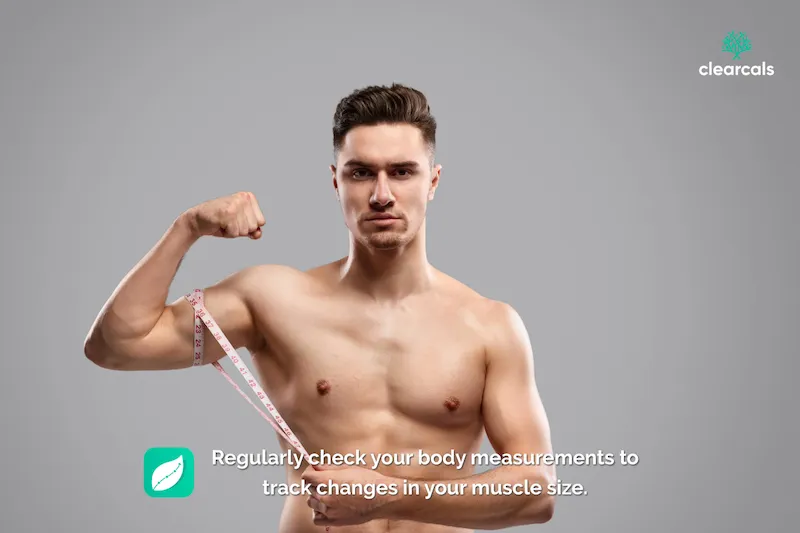Looking for a Personalized Diet Plan?
How to Measure Muscle Gain

By Dr. Krishna Athmakuri, Co-Founder & CEO of Clearcals
Building muscle is a rewarding journey that requires dedication, consistency, and effective monitoring of your progress.
Whether you're aiming to increase muscle size, strength, or overall definition, tracking your gains is essential for evaluating the effectiveness of your workout and nutrition regimen.
In this blog, we'll explore various methods to measure muscle gain accurately and how to utilize these tools effectively on your fitness journey.
1. Measuring Muscle Size
Body Measurements: Taking specific body measurements is a straightforward way to track changes in muscle size over time. Use a flexible measuring tape to measure key areas such as:
- Arms: Measure the circumference of your biceps and triceps.
- Chest: Measure around the fullest part of your chest.
- Thighs: Measure around the largest part of your thighs.
- Waist: Measure around your waist at the narrowest point.
- Calves: Measure around the largest part of your calves.
Track your body measurements at regular intervals (e.g., every 2 weeks) to monitor progress effectively.

2. Assessing Strength Gains
Lifting Progress: Strength gains are a key indicator of muscle development. Keep a workout journal or use the Pro workouts feature on the Hint app to record your lifts, including:
- Weight Lifted: Track the amount of weight you lift for each exercise.
- Number of Repetitions: Note the number of reps performed per set.
- Sets: Record the total sets completed for each exercise.
Progressive Overload: Aim to gradually increase the weight or resistance used in your exercises over time to ensure continual muscle adaptation and growth.
3. Body Composition Analysis
Body Fat Percentage: Tracking changes in body fat percentage can help assess muscle gain relative to fat loss. Methods for measuring body fat include:
- Skinfold Calipers: Measure skinfold thickness at various sites to estimate body fat percentage.
- Bioelectrical Impedance Analysis (BIA): Uses electrical currents to estimate body composition (muscle mass vs. fat mass).
- DEXA Scan: Dual-energy X-ray absorptiometry provides precise measurements of bone density, muscle mass, and body fat percentage.
Some fitness apps integrate with smart scales or BIA devices to automatically track body composition changes over time.
4. Visual Progress
Progress Photos: Take photos regularly from different angles to visually track changes in muscle definition and size. Compare photos over weeks or months to observe subtle differences in muscle development.
Clothing Fit: Notice changes in how your clothing fits as an indicator of muscle gain and body composition changes.
5. Consistency and Patience
Establish Baselines: Start by establishing baseline measurements and benchmarks before beginning a muscle-building program. This provides a clear starting point for tracking progress.
Monitor Trends: Focus on long-term trends rather than day-to-day fluctuations. Muscle gain is a gradual process, and consistent tracking helps you stay motivated and adjust your approach as needed.
Conclusion
Tracking muscle gain involves a combination of quantitative measurements (such as body measurements and strength gains) and qualitative assessments (such as visual progress and clothing fit).
By utilizing tools like the Hint app for logging measurements, tracking workouts, and setting goals, you can streamline the process and stay motivated on your fitness journey.
Remember, muscle gain is influenced by various factors, including training intensity, nutrition, rest, and genetics.
Consistency, patience, and a systematic approach to tracking progress will ultimately help you achieve your muscle-building goals effectively and sustainably.
Embrace the journey, celebrate milestones along the way, and continue to challenge yourself to reach new heights in fitness and strength.
About the Author
Dr. Krishna Athmakuri is the Co-Founder and CEO of Clearcals, where he leads the development of data-driven health technology through the Hint app.
With a Ph.D. in Chemical Engineering from Rensselaer Polytechnic Institute, New York, his expertise spans analytics, protein chemistry, and biotechnology.
Earlier in his career, he developed biotherapeutics for diabetes and metabolic diseases at companies like Aurobindo Pharma and Dr. Reddy's Laboratories.
At Clearcals, he now applies that scientific rigor to build personalized fitness tools, including Hint Pro Workouts, nutrition tracking, and real-time metabolic insights — helping users make smarter health decisions through technology.
🔗 Connect with Krishna on LinkedIn





